Top Productivity Metrics Examples & KPIs To Measure Performance And Outcomes
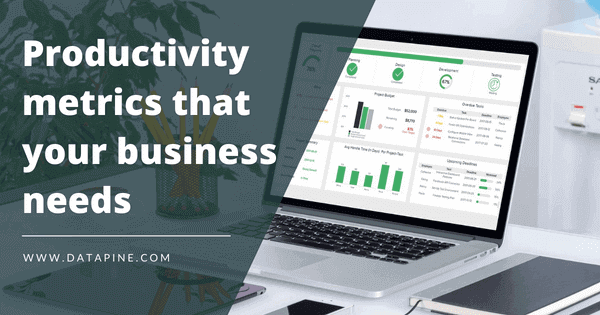
Table of Contents
1) What Are Productivity Metrics?
2) How To Measure Productivity?
For years, businesses have experimented and narrowed down the most effective measurements for productivity. Productivity can be measured in many different ways and at different levels, from the raw industrial output of an asset in a manufacturing facility to the specific individual sales performance of a vendor. Today, employee output is no longer represented by vague descriptions but by isolated figures that offer insight for improvement in specific areas, which can be found on an HR dashboard.
There are a lot of KPI examples out there to monitor progress and assess productivity. Likewise, there are a lot of guides on how to be productive at work. Each industry, business, and department has tailored its definition of individual productivity that performance indicators can assess. Let's take a look at our selection of essential metrics you can use to improve your organization's performance in several areas.
What Are Productivity Metrics?
Productivity metrics are measurements used by businesses to evaluate the performance of employees on various activities related to their general company goals. These metrics are used to highlight improvement opportunities and ensure maximum efficiency and productivity.
In short words, productivity is the effectiveness of output; metrics are methods of measurement. They are, by definition, how businesses evaluate productivity, usually that of their employees.
Productivity KPIs provide valuable insights into how well resources are being utilized and help identify areas for improvement. But it's not just about output; productivity metrics for employees go beyond mere numbers. They also consider factors like time management, quality of work, and collaboration.
One commonly used productivity KPI is the time spent on tasks. This helps track how much time is allocated to different activities and reveals potential bottlenecks or areas where businesses can streamline processes. Another example is the number of completed tasks or projects within a given timeframe. This KPI sheds light on overall productivity but is stronger when complemented by other indicators like customer satisfaction or revenue generated.
Productivity KPIs can often act as intertwining categories. Sales goals and profit margins are all performance metrics examples that businesses reference, but it goes much deeper than that. Sales bring in profits; the management of those profits is heavily influenced by the metrics used to gauge productivity throughout a business.
While measuring productivity through data is important, remember these numbers alone don't tell the whole story. Productivity doesn’t always equate to success— just because you serve 100 customers in an hour doesn’t mean you’ve done so with accuracy or good service, for example. These metrics should be analyzed in context and supplemented with additional information to learn more about what the numbers are telling you.
It’s also worth noting that focusing solely on output can lead to burnout or sacrificing quality for quantity. Organizations need to balance tangible results and intangible aspects like innovation, creativity, and employee well-being when using productivity benchmarking and metrics as guiding tools for success.
Because of this, there are some performance metrics examples and indicators to help increase employee productivity for every department. Professionals in human resources, management, customer service, and more can all benefit from the data in their productivity metrics.
Use our 14-day free trial and start measuring your productivity today!
How To Measure Productivity? Best Practices to Set Your KPIs
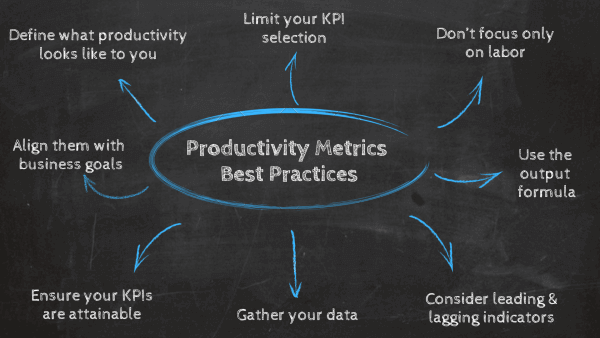

Measuring productivity can mean many different things. Do the employees finish their projects on time and to instruction? What about the output of those efforts? If they do all of those things according to what they are told, but there is still no sales growth, where are adjustments needed? Finding the answer often takes more than one metric. So, how do you track productivity?
Despite different companies needing to track different information, some common guidelines should be followed to define successful productivity measurements. Let’s look at some of them.
- Define what productivity looks like: How we measure it can vary between businesses. For example, some businesses believe that letting their employees use social media during the workday can be a productive habit, while other employers consider it a reason for disciplinary action. Without these measurements, it would be more difficult to substantiate any assertions, one way or the other.
- Limit your KPI selection: You don’t have to measure everything, nor should you try. Measuring too many KPIs can become a job and take away from more productive work. It can also distract you from making impactful changes because you’re focusing on too many “priorities” at once, which makes it harder to know where to focus your time and resources.
- Don’t focus only on labor: The first thing you should consider when measuring how productive your company is is to use the correct scope. According to an article in Harvard Business Review, measuring productivity in a modern business context is not only about direct labor but about a lot of other non-labor areas. As the author states: “single-minded attention to direct labor can produce unexpected consequences”. For this reason, your analysis scope should include anything that might affect the final output apart from direct labor.
- Use the output formula: Next, you need to understand the output formula: productivity= units of output/units of input. Traditionally, this formula is used to understand the revenue to total working hours. For this purpose, businesses divide the output (total revenue of a specific period) by the inputs (total worked hours during that period) to understand their overall productivity. That said, and considering the first point, this approach is only useful to monitor labor productivity. To get a wider scope, inputs can be defined as other factors, such as output per machine or output per ton of material. This way, you will ensure you get a full picture of all aspects related to how productive your company is.
- Consider both leading and lagging indicators: Leading indicators are predictive and can provide early insights into future performance. Examples include website traffic, social media engagement, and customer inquiries. On the other hand, lagging indicators measure historical performance and show results after an event has occurred. Revenue, profitability, or customer churn rate are common examples of lagging indicators. Both are important to paint the full picture of productivity, as understanding cause and effect can help you know what results to expect if you make changes.
- Align your indicators with specific business goals or objectives: Start by identifying the specific outcomes you want to achieve and then narrow down the relevant KPIs to help you monitor progress towards these goals. Remember that not all KPIs will be relevant to every business unit or project. Carefully evaluate each metric based on its applicability and value in driving positive organizational change.
- Ensure your KPIs are attainable: There’s no point in choosing KPIs your team won’t be able to track or meet minimum performance standards. Understand what data you need to measure a particular KPI, whether that data is readily accessible, and how to surf that data to track it. Bottlenecks in this process could make your KPI useless or at least take away from its value.
- Gather the data: Once you have understood the scope and how to measure it, it is necessary to gather the needed data. The information you use will, of course, depend on your outputs, but it will most likely include worked hours, tasks completed, time spent on each task, revenue generated, and costs, just to name a few. Managing this raw data is not an easy task. To ensure efficient information management, you can support yourself with an online data analysis tool to help structure your data and leave it ready to extract insights.
Now that you understand productivity measurement for your organization, it is time to look at some examples of productivity KPIs and metrics covering different areas.
Productivity Metrics Examples You Can Use
These productivity metrics examples are as interchangeable as they are targeted. You can conduct customized assessments per department while sharing certain metrics across the board. Below are examples that can be both specific and universal in gauging output across departments. For more metrics, you can find inspiration in our KPI examples list for different industries, platforms, and functions.
1. Employee Productivity Metrics
a. Overtime hours
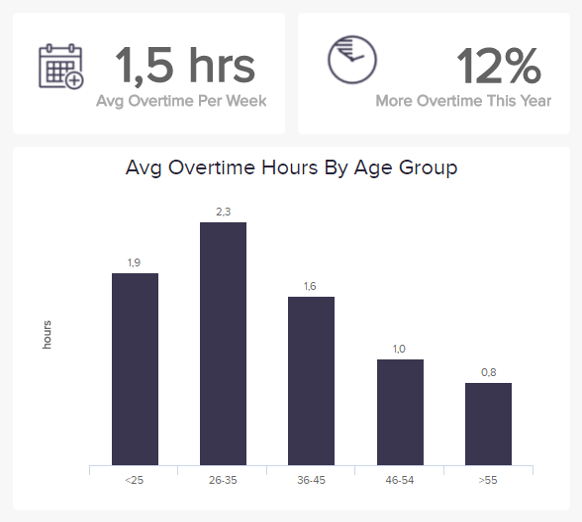
Overtime is a good way to gauge the cost and output of individual employees, though consideration of context is important for this productivity metric. For example, if the company has a spike in sales, people have to work harder to deliver on the promises they are selling. If overtime hours are a direct result of a heightened workload, this may indicate that you need to hire more talented employees instead of reviewing the ones in place.
Also, look closer by evaluating OT with other employee productivity KPI examples such as workload. You can see, and therefore work to prevent, the mistakes that inevitably happen in an overworked team. Another common symptom of an overworked team is a higher rate of absenteeism. You can dig deeper into this topic by looking at our HR reports article, gathering examples and templates.
b. Overall labor effectiveness
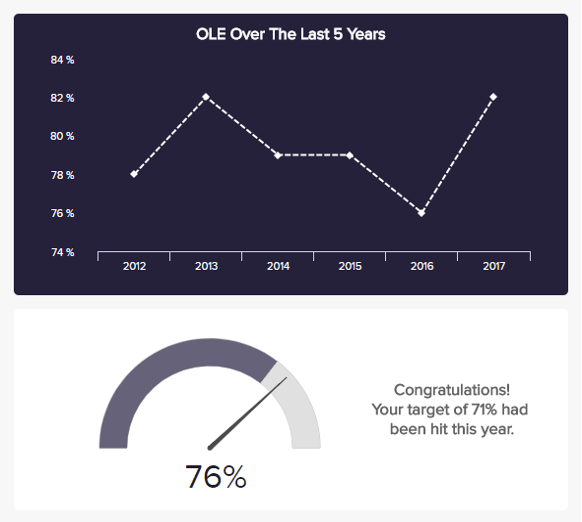
Overall labor effectiveness is a multi-faceted KPI that connects a number of details, such as the amount of staff, shift effectiveness, and more. This is essential for human resources departments because it provides the information they need to answer complicated staffing questions.
Calculating the OLE by dividing the total sales by the number of employees is a very straightforward and simple way to achieve the answer. Yet, once again, while this is a great metric, there should always be other indicators to consider that impact productive output, such as the amount of product delivered, quality control, and more. There is a manufacturing element here that draws appeal to all industries. Professionals who calculate overall labor effectiveness are able to understand exactly what the company has achieved and how efficient their workforce is regularly.
c. Part-time employees
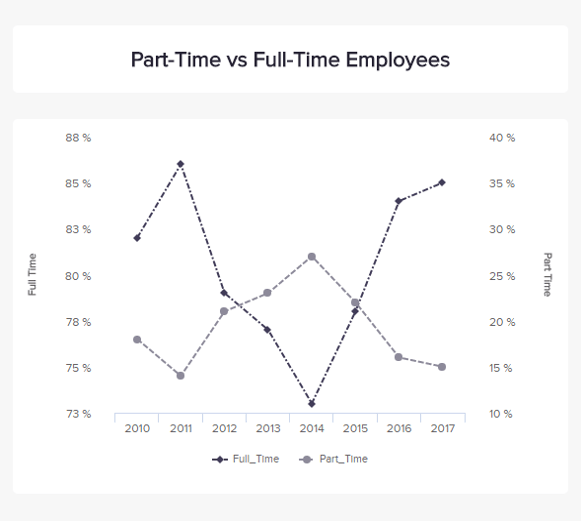
Part-time employees work fewer hours than their full-time counterparts, potentially leading to lower productivity. There are several business benefits of having part-time employees but understand that having multiple part-timers as a way to avoid hiring a few full-time employees can have detrimental effects on productivity. Part-time employees may take longer to learn the job, may have higher turnover, and may not be as invested in your company's culture or mission. Tracking part-time work alongside company performance, results, or employee satisfaction can reveal whether you might need to adjust your employee classification.
2. Recruiter Productivity Metrics
a. Turnover rate
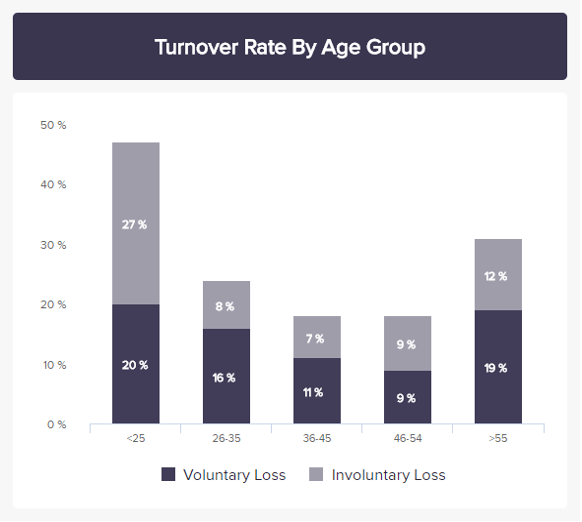
Turnover rate is an essential productivity metric used by human resources professionals to measure employee retention. Turnover is an inherent part of running a business. For better or worse, employees will come and go in accordance with their talents and desires. The turnover rate gives managers the ability to forecast a necessity for talent replacement so that no leftover duty of a leaving employee goes unassigned.
To calculate the turnover rate, choose a time period. Month-to-month is a common method here. From there, divide the number of separations by the number of active employees during that time period.
A low turnover rate is a sign of happy employees. It ultimately leads to, at the very least, lower recruiting and training costs. If your company has a high turnover rate, look to your managers to identify areas that need extra attention.
b. Recruiting conversion rate
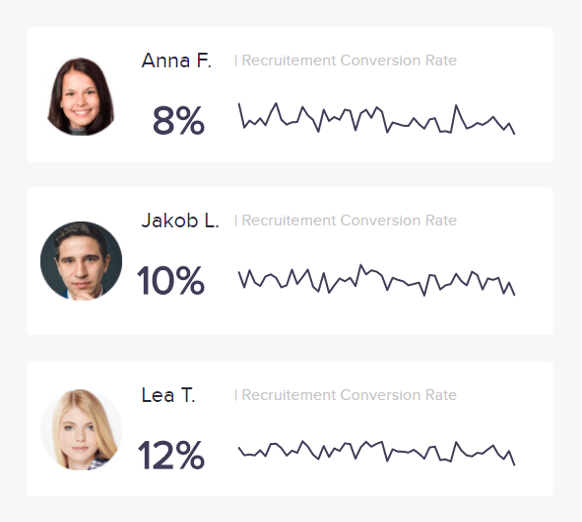
This is a unique indicator because it measures the performance of your human resources staff. Also, with this KPI, you will have to draw your own standards; the quality of your hires will determine the right or wrong.
To measure your recruiting conversion rate, simply compare the number of applicants to the number of hires. If you consistently find outstanding people with little effort, stick to the ratio you are currently implementing. If time, talent, and consistency become areas of concern, it may be helpful to spread out that ratio or even isolate those factors with other metrics, such as the following.
c. Time to fill
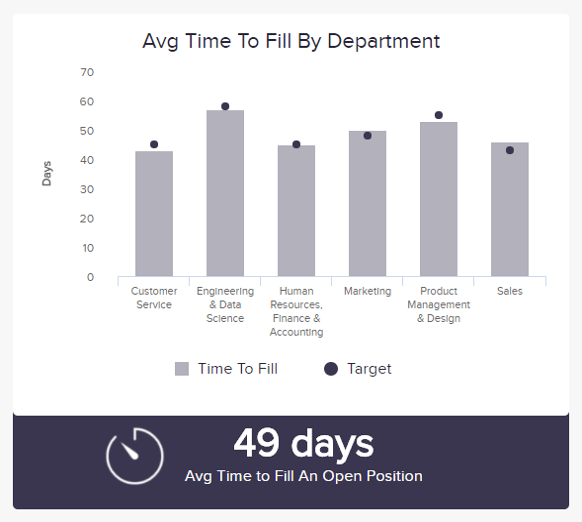
As the search for the perfect employee continues, the clock ticks. The work can pile up, causing other employees to become overworked and overwhelmed, often resulting in underperformance. In order to set a point of reference for your human resources professionals, the average time to fill is a helpful productivity metric.
To calculate time to fill, record the time it takes from a job posting to be created all the way up until the hire. Keep in mind that there is no standard for time to fill. The number can be lowered or raised so long as the right employees are chosen with limited cost to the company. If either of those factors is not in place, the time to fill is worthy of experiment.
3. Sales Productivity Metrics
a. Sales growth
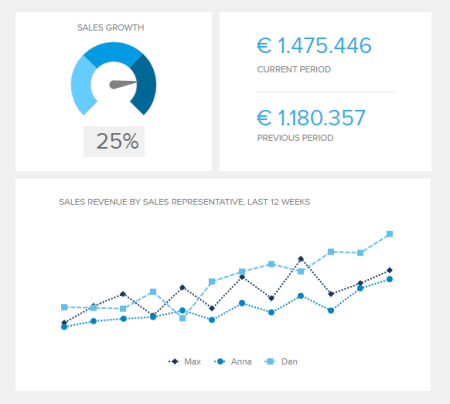
For sales departments and most businesses as a whole, this is the most obvious productivity metric worth assessing. In order to measure sales growth in an actionable fashion, track the individual performance of sales employees against their targets and territories. Be flexible, see what’s working and what isn’t, and readjust as necessary to ensure better productivity from your sales employees.
b. Revenue per sales rep
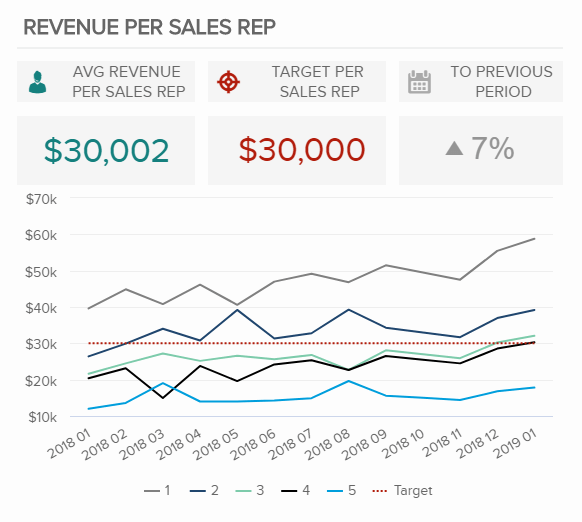
This next sales KPI is another great productivity indicator as it shows you the ability of your sales representatives to generate revenue for your organization. By setting ambitious but realistic KPI targets and goals for your reps, you can easily measure their performance and find improvement opportunities by comparing productivity against a benchmark month or last period.
In order to make the most out of this indicator, it is also important to divide your sales rep under different categories such as level of seniority, channel on which they are selling, and any other relevant aspect. This way, you will make sure you are being fair when it comes to evaluating their progress.
c. Opportunity-to-win ratio
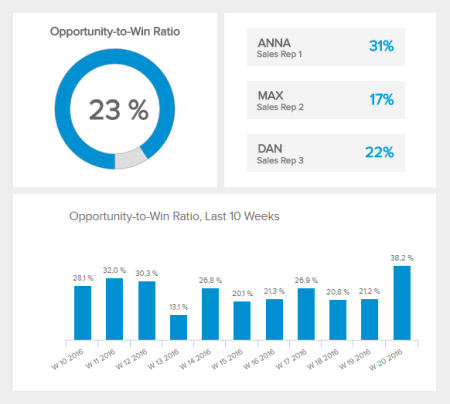
Not all of your qualified leads will result in a sale, but it’s helpful to know how many of them make that full journey. This can shine a light on a sales manager’s effectiveness in closing deals, which tells you how much money they’re driving into your business. A high opportunity to win compared to a low win rate could mean your sales team needs additional training or other resources in order to close more deals.
4. Call Center Productivity Metrics
a. Top support agents

Your top talent deserves to be recognized, and relying on productivity KPIs enables a manager to remain objective when determining the strongest players. Here are some of the customer service-based indicators you can cross-reference to determine your best support agents:
- First call resolution
- Average calls per hour
- Customer satisfaction surveys
- Sales success
These indicators can help you identify the team members most eligible for managerial positions, as well as those who may need a little more training in specific areas.
b. Customer satisfaction
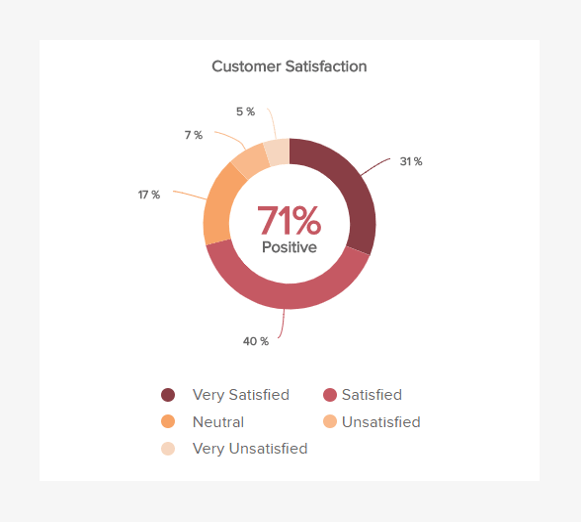
Arguably one of the most important customer service or call center productivity metrics, customer satisfaction can provide several insights into the quality of service your company is providing. Compared to some of the other examples in this post, the satisfaction KPI can be a bit harder to measure as it requires a different approach to data collection, such as performing a feedback survey to your clients.
That said, many customer service analytics solutions make this process way easier by providing automation technologies for this process. With the help of the right tool, you can set up different instances to gather feedback from your clientele and pinpoint different areas in which your service could be improved.
c. First call resolution (FCR)
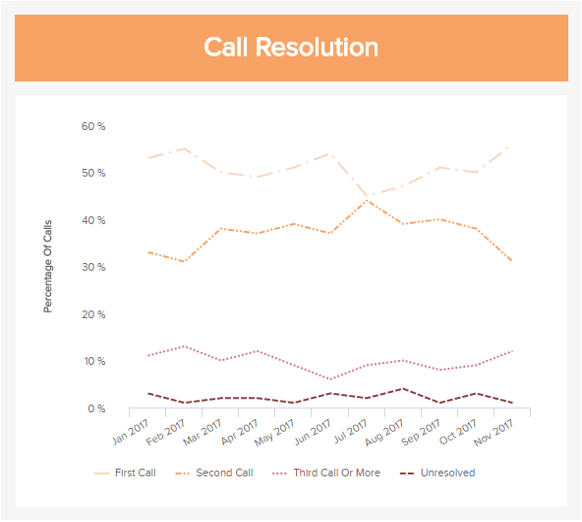
The most efficient thing your call center team can do is to resolve the caller’s issue or request on the first call. Otherwise, your team must escalate tickets, handle callbacks, and further delay problem-solving. A low FCR could indicate the need for more training on communication and resolution options. Call scripts, surveys, and knowledge bases are also helpful tools in improving this metric.
5. Productivity Metrics In Manufacturing
a. Production volume
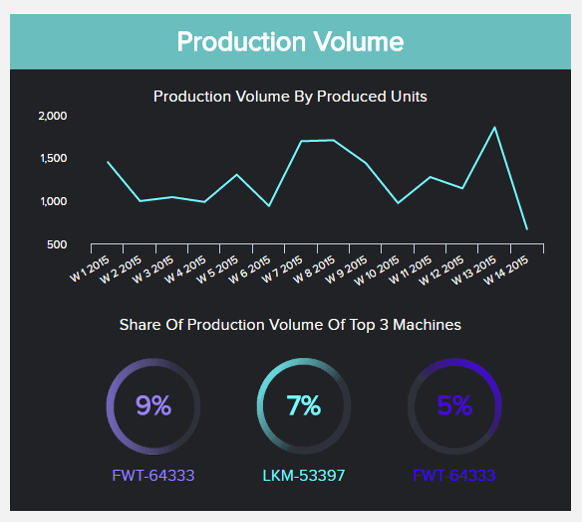
When we are talking about manufacturing KPIs, there is a key one that needs to be tracked to efficiently assess productivity. This is the production volume. Typically, a manufacturing company has to deal with multiple production deadlines to cover the demands of their clients. With that in mind, this straightforward KPI will help you understand if you can meet your targets and how you could improve.
Now, since the production volume alone won’t tell you enough about where you could improve, it is important to analyze this metric a bit deeper and compare the productivity of different machines. This way, you can see if a specific machine is underperforming and find solutions to ensure your production process is fully optimized.
b. First Pass Yield (FPY)
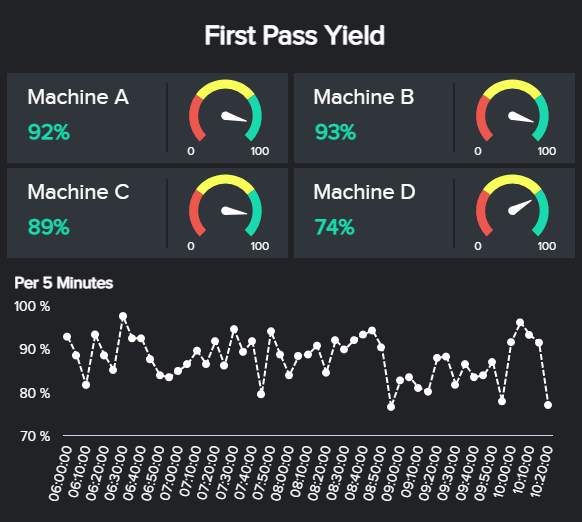
Following the same line as our previous example, we have the first pass yield (FPY). As one of the most relevant manufacturing productivity metrics templates, the FPY assesses the quality and performance of your production process. It does this by dividing the number of perfect units (with no reworks or defects) by the total number of produced units entering the same process in a specified time.
In a perfect world, a company would aim for an FPY of 100%. But, given that this is not entirely realistic, it is a great productivity measure for achieving final production times on schedule and with the required quality. This indicator can be compared to other important ones, such as the throughput or the scrap rate, and visualized together in a professional manufacturing dashboard.
c. Overall operations effectiveness (OOE)
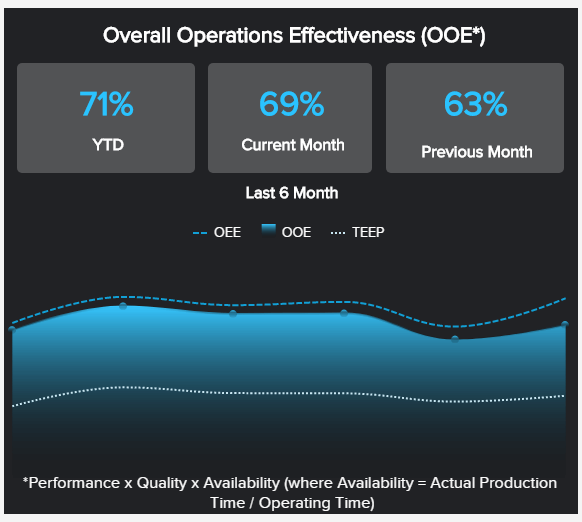
Getting a bird’s eye view of your entire operation is critical in manufacturing, and that’s precisely what the overall operations efficiency metric measures. It multiplies the performance with quality and availability (availability equals the production time divided by the operating time). Using this metric, you can dial deeper into specific areas of your operations to see how various functions help or hinder OOE.
Use our 14-day free trial and start measuring your productivity today!
6. Marketing Productivity Metrics
a. Goal conversion rate
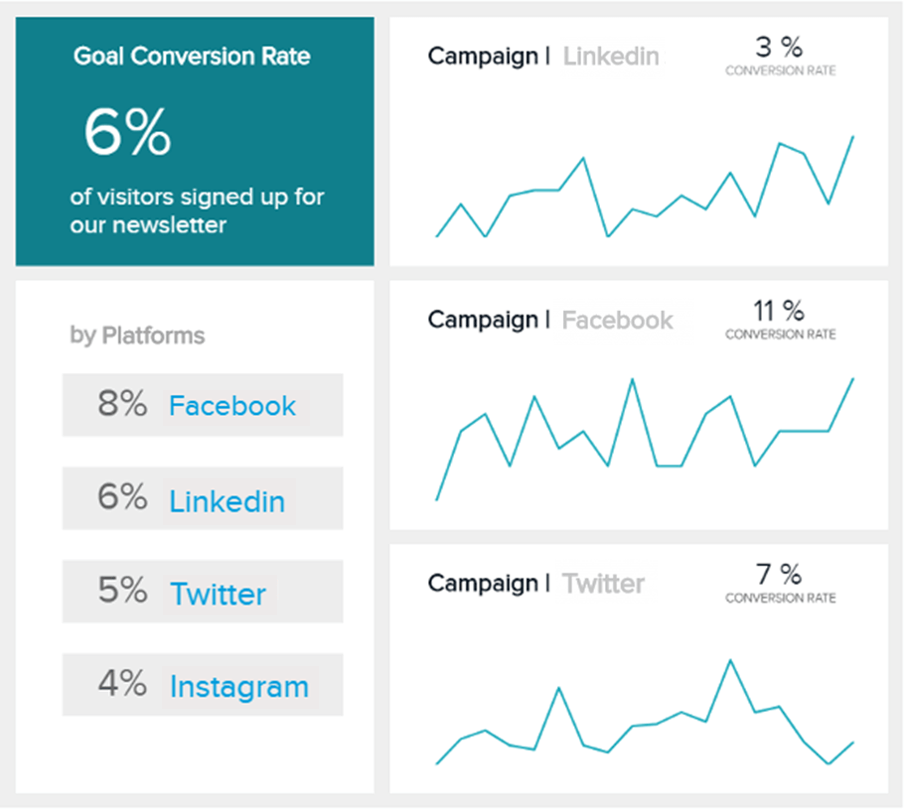
The conversion rate is one of the greatest indicators to measure the efficiency and productivity of the marketing department, as a high conversion rate means a successful strategy. In short, a conversion is any desired action made by a visitor, user, or client, as you want to call it. Of course, the type of conversion will depend on the business and the strategy being measured. It can be anything from a newsletter subscription, downloading a guide, or signing up for a free trial, just to name a few.
By setting clear conversion goals for your different campaigns and channels, you can easily understand what type of strategy works best for your business and optimize resources to ensure an excellent marketing ROI. This leads us to our next example.
b. Lead-to-MQL-ratio
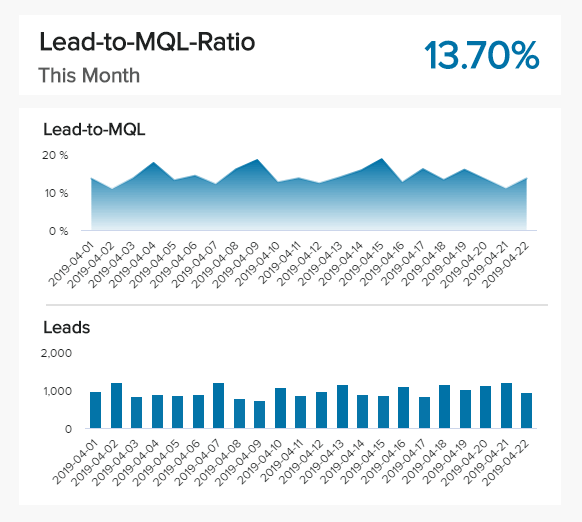
MQLs, or marketing qualified leads, are one of the most important performance measurements for the marketing department. Essentially, an MQL is a potential customer that has been recruited by the marketing team and that meets all the criteria to be derived to the sales team to become a paying customer.
This is done by gathering multiple leads via different strategies such as content marketing, paid search, or social media strategies, and once leads are generated, the marketing team defines which ones will turn into MQLs. The higher the lead-to-MQL ratio, the more successful your company is at qualifying leads.
c. Website-traffic-to-lead ratio
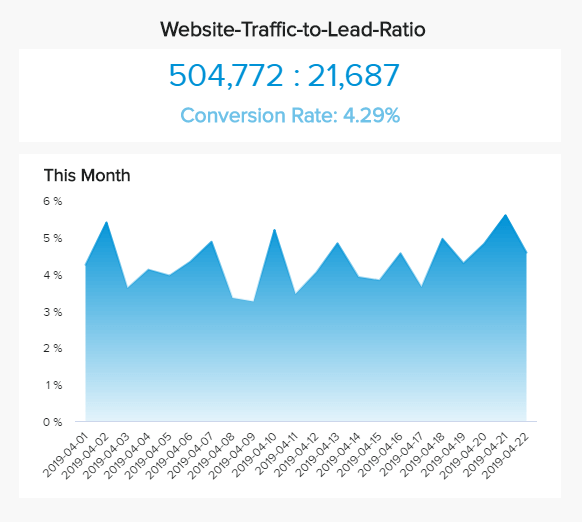
Getting customers to your website isn’t the end goal—you also want as many qualified visitors as possible to take the next step. The website traffic-to-lead ratio measures the percentage of users that take additional action, also called a conversion. This might be to make a purchase, create an account, request a demo, or some other activity that shows they’re interested. A high website traffic-to-lead ratio indicates you’re attracting quality traffic. Conversion rates that decrease over time can be reviewed alongside other marketing metrics to determine the cause and help you rebound.
7. Inventory Productivity Metrics
a. Inventory turnover
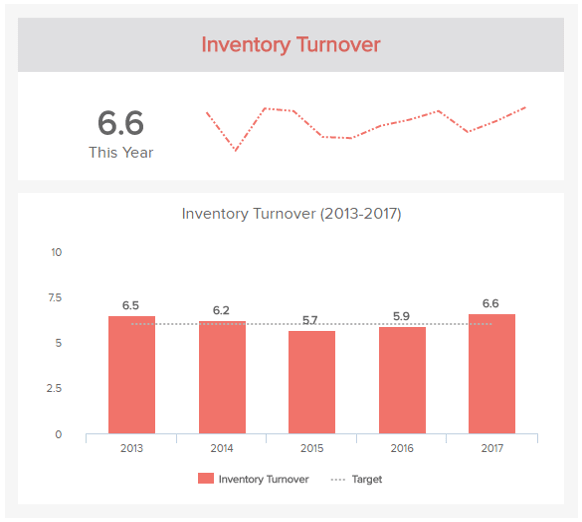
The inventory turnover is a productivity metric that measures how many times your total inventory was sold and replaced during a specific period, usually a year. This is a great indicator to measure the efficiency of many business areas, such as production management, marketing, and sales.
In general, a low turnover rate can mean something is not working at some stage in your supply chain. However, this is not necessarily always the case. Some companies might have a lower turnover because they are selling more expensive products or services that stay longer on the “shelf”. Therefore, it is important to set realistic turnover targets based on the industry.
b. Inventory to sales ratio
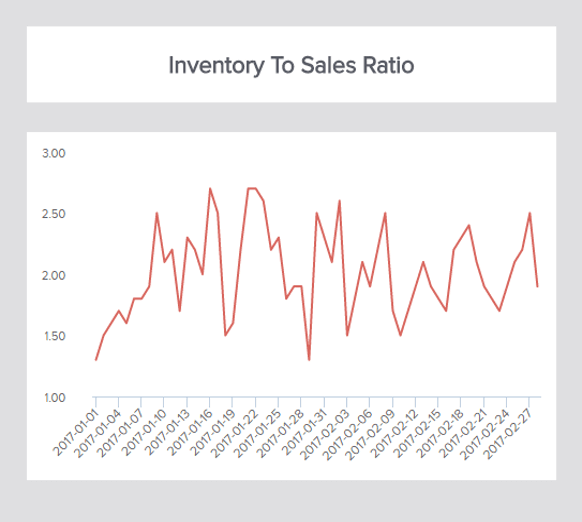
Following on the same line as the turnover rate, another great example is the inventory-to-sales ratio. This most insightful of logistics KPIs tracks the amount of inventory in your stores compared to the number of sales, and it is utilized to identify overstock and measure the performance of your inventory management process.
Inventory management is one of the most expensive activities for an organization. The more time you have unsold stock in storage, the more it will cost you. With that in mind, a good practice is to keep your inventory and sales volume at a similar level. If you notice that your stock is too high, but you are already reaching your sales targets, you might be producing more inventory than you need, which is costly in time and money.
c. Inventory accuracy
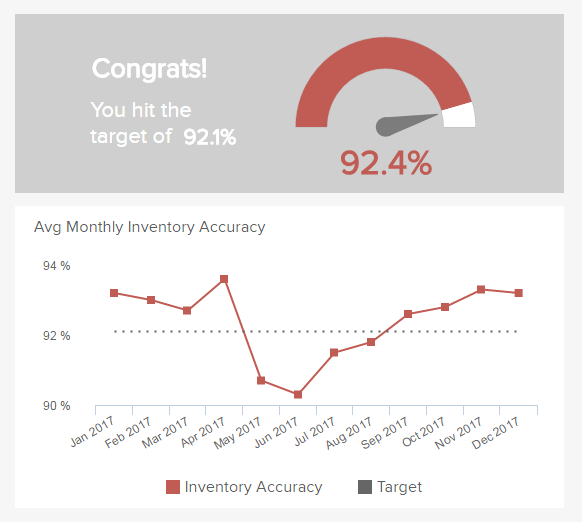
Inventory accuracy has a powerful effect on sales and customer satisfaction. Tracking this KPI can help you avoid problems caused by inaccurate inventory while maintaining your squeaky-clean reputation as a reliable supplier. A low inventory accuracy measurement could indicate poor bookkeeping practices, inefficiency in your warehouse, or even employee theft, all of which can create their own ripple effects of consequences.
8. Productivity Metrics In Healthcare
a. Patient satisfaction
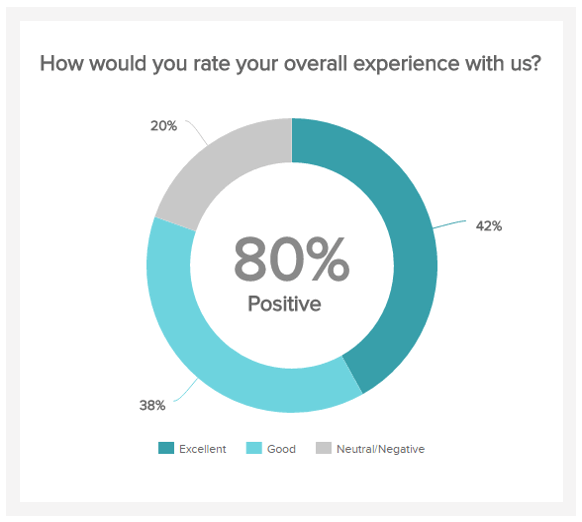
Moving on with some examples from the healthcare industry, we first have the patient satisfaction KPI. Just like customers are the most important aspect of a business, patients are the most important aspect of a health organization. Therefore, measuring their satisfaction level is a great indicator to assess efficiency and productivity across departments and areas.
The most important of KPIs for productivity includes anything from the quality of meals, average waiting times, and treatment efficiency, among many others, and it can tell facilities where to focus their improvement efforts.
b. Hospital readmission rates
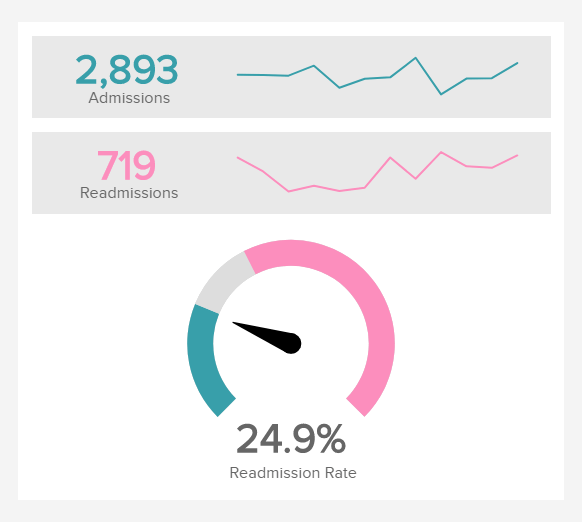
Our final example is the hospital readmission rates tracked in an interactive gauge chart, which provides insights into the quality of your health service. This indicator directly affects your patient satisfaction levels as it measures the number of patients that return to the hospital within a short period of time after being released.
High readmission rates can shine a light on a number of managerial issues, such as understaffing or an overloaded staff neglecting details that make patients have to come back. Identifying these productivity issues can lead to decreasing unnecessary costs from readmissions as well as offering better service in general.
You can track this and other relevant metrics with the help of an intuitive healthcare dashboard.
c. Treatment error rate
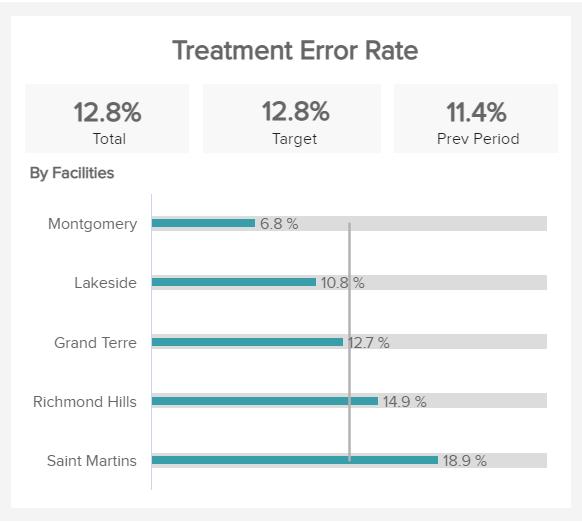
Mistakes happen, even in critical fields like healthcare. However, with patient lives in your hands, it’s imperative to reduce the potential for error in every way possible, which is why tracking the treatment error rate is so important. This productivity KPI shows the number of mistakes made by clinical staff when treating patients. Errors might include prescribing the wrong medication, incorrect diagnoses, or providing the wrong treatment, among other things.
9. IT Productivity Metrics
a. Mean Time To Detect
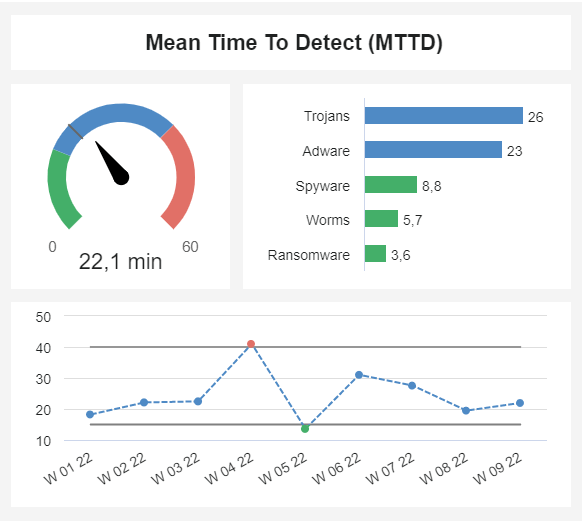
The sooner you detect an attack, the faster you can mitigate its impact. The mean time to detect measures how long a security threat goes unnoticed before an IT team member addresses it. Your goal should be to keep this metric as low as possible to ensure safety and privacy across your technology ecosystem. However, several factors could affect this indicator, including the type and complexity of the threat, as well as the availability of your IT staff. Use this metric as a jumping-off point to find areas for improvement.
b. Mean time to repair
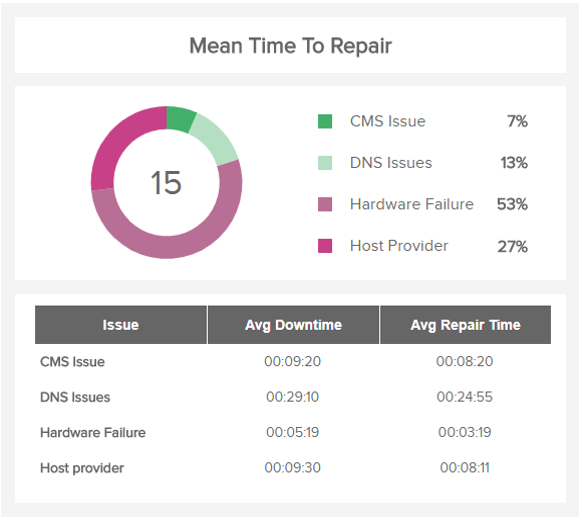
Mean time to repair is as much a measure of confidence and competence as it is productivity. It illustrates how quickly your IT team is addressing issues when they’re noticed. This IT KPI encompasses the entire repair timeline, from diagnosing issues to fixing, testing, and calibrating. The results can indicate your team’s capabilities in facing problems in real-time and whether additional training or staffing might be necessary.
c. Backup frequency
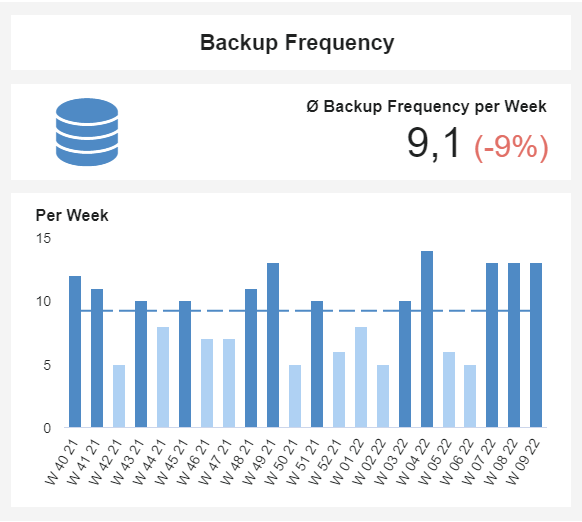
Backing up your data is critical to keeping your business intact. Whether you’re automatically performing data backups or running manual backup sessions, it’s important to know how often your data is being preserved. You never know when a cyber attack might freeze your systems or wipe out critical information, and knowing your backup frequencies can help you plug any holes in your backup strategy.
Enhance Employee Productivity Through Metrics
Now that you’ve acquired the data, it is time to apply that knowledge and make your business more productive. But first, scrutinize your data. Remember that the circumstances surrounding these measurements should always be considered. Chance is certainly one of those circumstances. For example, a customer service agent who fields a significantly larger number of angry customers may not be the one causing the problems. Factors such as time of day, other workers on duty, and more can be influencing that influx of negativity. Furthermore, that very agent dealing with all these scenarios could become your future leader in conflict resolution.
Second, make sure your data covers a reasonable time period for evaluating your chosen productivity metric. Track metrics for months, not days, so that the report is thorough enough to produce actionable feedback.
Finally, we now know that the employees' well-being plays a big role in their productivity. This is why setting up and tracking employee satisfaction metrics can be a relevant measure for you to take to see how your different initiatives in the matter impact their productivity. An HR analytics software is the ideal tool to manage all the data you will collect after setting up your metrics.
Once you’ve double and triple-checked your productivity KPIs, it is time to start making some changes. There are simple habits you can teach your employees to make them more productive. Perhaps there are changes to be made in staffing, scheduling, or operations. No matter what you decide to do about your data, make sure you keep recording. Future data will prove the effectiveness of your remedies, allowing for more productive solutions in the future.
Use our 14-day free trial and start measuring your productivity today!
Find The Right Workforce Productivity Metrics Today
Business efficiency is a concept that is built over time within every company. Employee productivity is one of the biggest drivers of that efficiency. In order to boost performance, cut costs, and retain both customers and employees, productivity KPIs should be an accelerating part of the conversation.
At datapine, we specialize in helping our clients enhance their businesses. To start measuring your productivity and performance, read more about our self service BI tool or sign up for a 14-day free trial today!